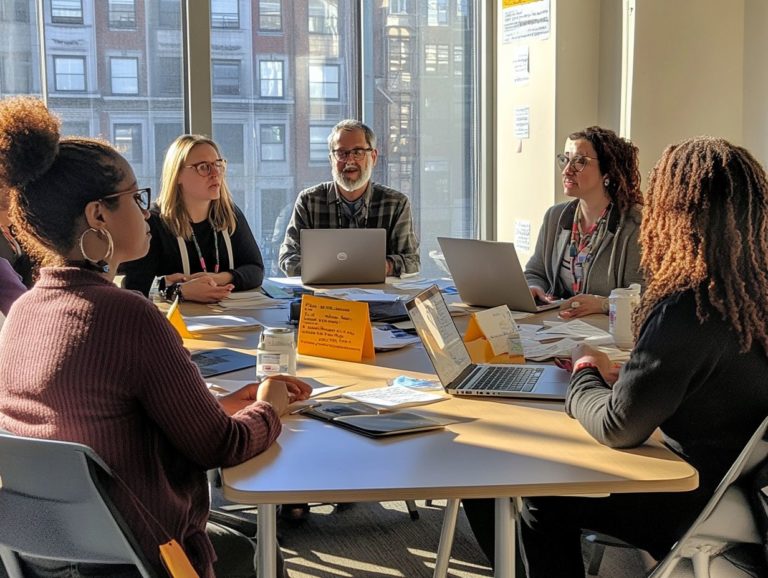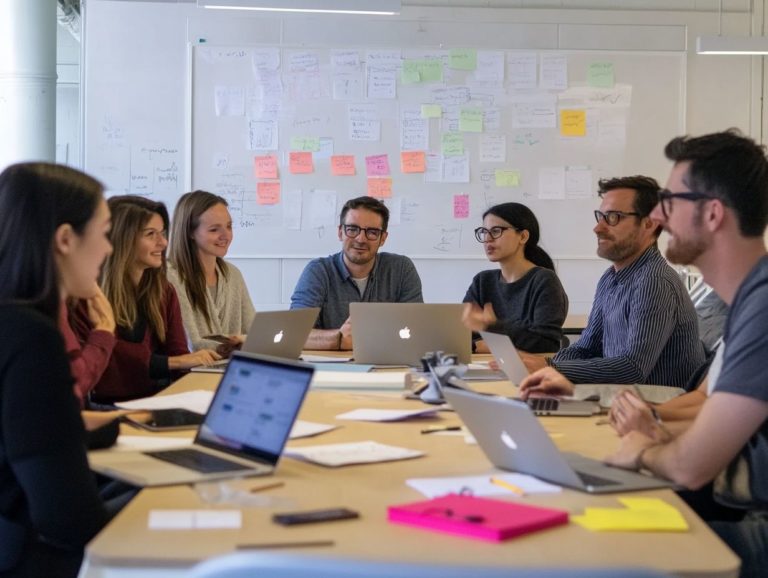How to Create an Inclusive Skill Enhancement Program
In today s diverse landscape, creating opportunities for growth through an inclusive skill enhancement program is vital for every participant.
This article will explore the essence of inclusivity and its critical role in skill development. You will discover common barriers that impede inclusivity and explore practical strategies to overcome them.
With valuable insights on designing, implementing, and evaluating effective programs, this guide equips you with the tools necessary to foster an environment where everyone can thrive.
Embark on this essential journey toward inclusiveness and unlock the potential that lies within all participants.
Contents
- Key Takeaways:
- Understanding Inclusivity in Skill Enhancement Programs
- Identifying and Addressing Barriers to Inclusivity
- Designing an Inclusive Skill Enhancement Program
- Implementing an Inclusive Skill Enhancement Program
- Evaluating the Effectiveness of an Inclusive Program
- Frequently Asked Questions
- What is an inclusive skill enhancement program?
- Why is it important to create an inclusive skill enhancement program?
- How can I create an inclusive skill enhancement program?
- What are some best practices for creating an inclusive skill enhancement program?
- How can I ensure that my inclusive skill enhancement program is successful?
- Are there any resources available to help me create an inclusive skill enhancement program?
Key Takeaways:
- Always keep inclusivity at the forefront when designing a skill enhancement program to ensure equal opportunities for all participants.
- Addressing and overcoming barriers to inclusivity is crucial for the success of any skill enhancement program.
- Regular evaluation and improvement of an inclusive skill enhancement program is necessary to ensure its effectiveness and impact.
Understanding Inclusivity in Skill Enhancement Programs
Understanding inclusivity in skill enhancement programs is crucial for cultivating a workplace that genuinely values diversity while fostering engagement and productivity among every employee. By embracing inclusive training practices, you can significantly boost employee retention and ensure that your learning and development initiatives align with the future of skill enhancement programs, accommodating a variety of learning styles and mental health needs.
A steadfast commitment to inclusivity creates an environment where diverse individuals can flourish, promoting open communication and effective training methods led by knowledgeable leaders within your organization.
Defining Inclusivity and its Importance
Inclusivity in skill enhancement programs means taking a proactive stance to ensure that every employee, regardless of their background, has equal access to training opportunities. Learning how to facilitate effective skill enhancement sessions champions diversity and inclusion in the workplace.
This approach not only sharpens individual skills but also fosters a deeper understanding among colleagues, creating a vibrant and collaborative atmosphere. When you implement inclusive training strategies, you embrace the diverse perspectives and experiences that each employee offers, propelling employee engagement to new heights.
Such an environment invites individuals to voice their opinions and contribute meaningfully, paving the way for innovative solutions and heightened productivity. Ultimately, inclusivity in training cultivates a supportive workplace where everyone feels valued and empowered to flourish professionally.
Identifying and Addressing Barriers to Inclusivity
Identifying and addressing barriers to inclusivity in employee training programs is essential for cultivating a workplace that truly values diversity and fosters effective learning.
These barriers can manifest in various forms, such as mental health challenges, different learning styles, and training content that fails to meet the diverse needs of all employees.
By actively seeking feedback for improvement, you can tailor training initiatives to overcome these obstacles, ensuring that inclusivity remains a top priority in your organizational priorities.
Start today! Create an inclusive program that benefits everyone in your team.
Common Barriers and Strategies for Overcoming Them

Common barriers to inclusivity in employee training include a lack of awareness about diverse learning styles, ineffective communication skills, and unaddressed mental health concerns that hinder participation.
These challenges often manifest as disengagement or frustration, ultimately discouraging full immersion in the learning experience.
To tackle these issues, organizations should incorporate a variety of teaching techniques that cater to different preferences think visual aids, hands-on activities, and collaborative exercises. This approach ensures that you feel valued and included.
Fostering an open dialogue about mental health is crucial. Creating a supportive atmosphere where you feel safe discussing challenges enhances your sense of belonging.
Training facilitators in effective communication techniques bridges gaps, allowing for clearer messaging and encouraging feedback, nurturing a more inclusive environment for everyone.
Designing an Inclusive Skill Enhancement Program
Designing an inclusive skill enhancement program requires a thorough understanding of the diverse needs of employees. You should create effective training materials that resonate with various learning styles, following a roadmap for success.
Collaborating with experts in the field is essential to ensure that each training initiative fosters employee development and promotes retention. By prioritizing these elements, you can empower your team.
Key Components and Considerations
Key components of an inclusive training program focus on tailored learning strategies designed to enhance engagement and productivity while addressing the unique needs of every employee.
These strategies can include a variety of teaching techniques, peer mentoring, and assessments that cater to different learning styles. By creating a supportive environment for feedback, participants feel heard and valued an essential factor in cultivating a culture of continuous improvement.
Fostering collaboration among team members from diverse backgrounds enriches the training experience and cultivates a genuine sense of belonging. Ultimately, these elements create a cohesive training framework that drives individual growth and elevates overall organizational performance.
Implementing an Inclusive Skill Enhancement Program
Implementing an inclusive skill enhancement program requires a smart strategy that will energize your workplace. This approach incorporates the best practices for skill enhancement programs in training delivery, ensuring all employees feel valued and supported in an inclusive environment.
Your commitment to fostering an atmosphere where everyone can thrive is not just a goal; it’s a necessity for cultivating a diverse and empowered team.
Best Practices and Tips for Success

Best practices for effective training hinge on a proactive approach to seeking feedback and ensuring sessions are interactive and inclusive, which is key to maximizing employee engagement.
To accomplish this, it’s vital to cultivate an environment where participants feel at ease sharing their thoughts. Techniques like anonymous surveys or one-on-one conversations can be particularly effective for gathering candid feedback after each session.
By incorporating various learning styles such as multimedia presentations, group activities, and hands-on exercises you can cater to the diverse backgrounds of your employees.
This approach not only enriches the training content but also empowers participants to take ownership of their learning experiences. By prioritizing inclusivity and making informed adjustments based on feedback, organizations can significantly enhance the effectiveness of their training initiatives and foster a culture of continuous improvement.
Act now to foster an inclusive environment that empowers your team and enhances performance!
Evaluating the Effectiveness of an Inclusive Program
Evaluating the effectiveness of an inclusive skill enhancement program is essential for ensuring that your employee training initiatives achieve their intended goals. This process, including tailoring skill enhancement programs to employee needs, not only contributes to better employee retention but also significantly enhances overall workplace diversity.
Measuring Impact and Making Improvements
Measuring the impact of inclusive training programs requires you to gather both personal feedback and numerical data. These insights are invaluable for refining strategies that elevate employee engagement and cultivate an inclusive workplace.
By employing surveys, interviews, and focus groups, your organization can capture a spectrum of perspectives on the effectiveness of these initiatives. This feedback loop is essential, as it highlights areas needing fine-tuning while showcasing what s already working well.
Monitoring metrics such as participation rates and retention levels allows you to gauge how effectively employees are responding to the training. This continuous cycle of feedback ensures that future programs remain not just relevant but also resonate deeply with your workforce, fostering a thriving culture of inclusivity and engagement.
Frequently Asked Questions
What is an inclusive skill enhancement program?
An inclusive skill enhancement program is designed to provide opportunities for individuals of all abilities and backgrounds to develop their skills and reach their full potential. For example, learning how to integrate skill enhancement into daily work fosters an approach that builds a vibrant community where everyone thrives!
Why is it important to create an inclusive skill enhancement program?
Creating an inclusive skill enhancement program is essential for unlocking the full potential of your team. Understanding the evolution of skill enhancement programs ensures that everyone has equal access to resources and opportunities, promoting a more diverse and supportive community.
How can I create an inclusive skill enhancement program?
There are several steps you can take. First, assess the needs and interests of your target audience to ensure that the program is accessible to people of all abilities. Prioritize diversity and inclusivity in your program’s content and activities. Additionally, understanding how to measure skill enhancement effectiveness and providing appropriate support for participants with different learning styles is crucial.
What are some best practices for creating an inclusive skill enhancement program?
Best practices include involving diverse perspectives in planning, using inclusive language and materials, providing various learning opportunities, and continuously seeking feedback for improvements. It’s important to have trained staff who can effectively support participants from all backgrounds.
How can I ensure that my inclusive skill enhancement program is successful?
To ensure success, regularly evaluate your program’s impact and make necessary adjustments. Monitor participation rates, gather participant feedback, and track their progress. Consistently promote diversity and inclusion while creating a welcoming environment for all participants.
Are there any resources available to help me create an inclusive skill enhancement program?
Yes, many resources can assist you. Consult with diversity and inclusion experts, attend workshops or conferences, and utilize online tools and guides. Connecting with other organizations that have successfully implemented inclusive practices can also provide valuable advice and support.
Ready to take the next steps towards implementing an inclusive program? Let’s make a difference together!







